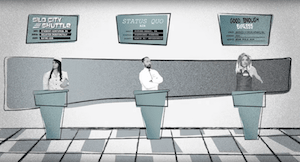
Education has changed quite a bit in five years.
District leaders find themselves challenged to forecast the future. Which career paths are students likely to pursue after they walk the graduation stage? With technology evolving at a breakneck speed, knowing where to invest precious budget dollars is an ever-increasing challenge. Next, district leaders must rally the community around the path they’ve calculated is the most fruitful for student achievement.
All this forecasting is murky. That’s where Future Ready Schools® comes in. Here’s what we said way back in 2015 about the organization’s vision:
The Future Ready concept is focused on the integration of digital tools, universal connectivity, and strategic instructional planning to prepare students for success after graduation, no matter their chosen path. The Future Ready District Pledge takes these concepts one step further by asking superintendents to commit to working "with educators, families, and community members to make all schools in their districts Future Ready" in exchange for ongoing support throughout the transitional phase.
At the time, about 2,000 superintendents had partnered with Future Ready Schools, seeking support to strengthen their school community around technology plans.
So what’s changed in five years?
While the Future Ready concept and organization have both evolved, their core focus has remained constant. If anything, the program has expanded as time goes on and educators continue encountering new challenges.
Back in 2015, the seven core tenants district teams focused on were:
- Curriculum, instruction, and assessment
- Use of time
- Technology, networks, and hardware
- Data and privacy
- Community partnerships
- Professional learning
- Budget and resources
Now, these seven categories look mostly the same, with some subtle but striking adjustments:
- Curriculum, instruction, and assessment
- Use of space and time
- Robust infrastructure
- Data and privacy
- Community partnerships
- Personalized professional learning
- Budget and resources
It’s interesting to note the longevity of the majority of each core tenant: the Future Ready approach is working. Even more interesting are the ways the concept has evolved. The use of space, or the design of the learning environment, has grown tremendously in focus according to the Future Ready success stories. The concept transcends technology as district leaders make changes to the traditional arrangement of school spaces.
Future Ready Schools stands in contrast to other tech efforts in that their method isn’t designed to be a rubber stamp on each district. Rather, district leaders identify their team (from school board members to community leaders to media specialists to middle school students) to decide mindfully how technology fits their own vision for student success. To borrow a Francis Bacon quote, technology is a good servant but a poor master. In a time when rumblings of automation abound—whether it’s the grocery store checkout, factories, shipping, or, astonishingly, teaching—the Future Ready framework strives instead to support leaders making mindful decisions without the pressure to choose the latest, greatest, shiniest trend. Instead, leaders invest in technology that fits their community’s unique needs. Students are truly prepared for their future.
This flexibility means the Future Ready concept is way more than pushing trendy mobile learning or 1:1 technology programs (which is not necessarily the course of action each school needs). Instead, the guidelines help schools build infrastructure and support for technology that’s most efficient and effective. Hundreds of resources give district leaders a framework to build their own focus.
Once that plan is in place, a built-in dashboard gathers the data leaders need to monitor progress, benchmark goals, and make adjustments. Overall, the Future Ready framework provides the support needed to help schools try new things to personalize instruction outside of traditional models. This may include alternative grading structures, different standards for promotion and retention, or new ways to schedule courses.
The Future Ready process also embraces community feedback to guide the implementation of new objectives. Partnerships with businesses and community features help leaders outside the school invest directly in local students’ development of useful skills.
It’s a daunting task to try new things on the district level. Budget-friendly, wise investments are required to be good stewards of the community’s investment in schools. The alliance of school leaders working with Future Ready Schools—currently some 3,400 districts, incorporating 2 million educators and over 20 million students—offer the insight needed to make big ideas work without taking wild risks.
The Future Ready framework is alive and well to support the everyday risks that add up to big gains in student achievement.
Follow-up Resource: Subscribe for more
Looking for more insight into K12 leadership? Subscribe to our newsletter and enjoy monthly updates.WHAT'S NEXT FOR YOUR EDTECH? The right combo of tools & support retains staff and serves students better. We'd love to help. Visit skyward.com/get-started to learn more.

|
Casey Thompson Web & Digital Media Manager |




